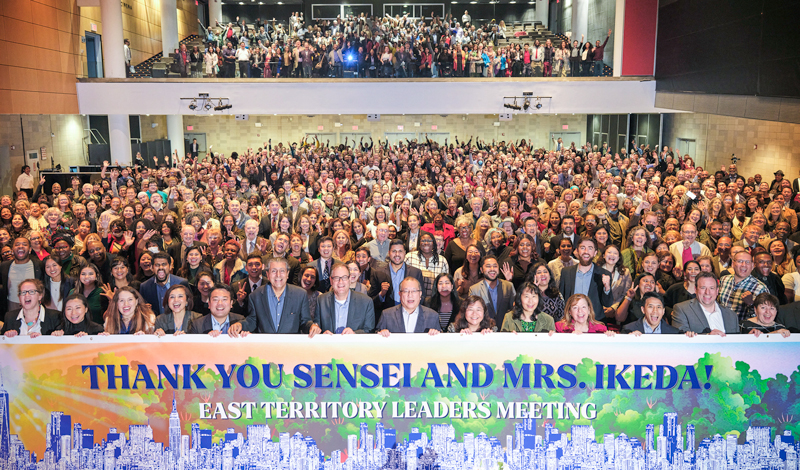Ikeda Sensei sent the following message to leaders meetings held at Columbia University in New York on May 20, 2023, and at the SGI-USA New England Buddhist Center in Brookline, Mass., on May 22, 2023.
My beloved American friends: I offer my heartfelt congratulations on holding this lively leaders meeting! Amid these unstable times, you have all been praying every day for peace as you strive diligently to expand our alliance of global citizens emerging from the earth.
Nichiren Daishonin writes: “The great correct Law will spread without fail. … When Bodhisattva Superior Practices emerged from the earth, did he not emerge dancing?” (“Great Evil and Great Good,” The Writings of Nichiren Daishonin, p. 1119).
The mission you all possess as noble pioneers of worldwide kosen-rufu is immense. I hope you will advance using times of hardship as opportunities to accumulate tremendous good fortune, joyfully chanting daimoku like the mighty lion’s roar. My mentor, second Soka Gakkai President Josei Toda, said:
Those who stand and face hardship with faith demonstrate the incredible power of the Buddha. Such individuals can truly encourage others and become allies of the suffering.
Let’s strengthen our faith and together joyfully advance, always on good terms with one another. Illuminate your communities and those you know with the light of encouragement and hope as your lives and efforts for kosen-rufu resound with songs of victory!
With our sights set on the Soka Gakkai’s 100th anniversary in 2030, let’s construct in the places of our vow exemplary castles of capable people, good fortune and happiness!
I am praying for the health, longevity and safety of all of you and your families.
Please take care!
Daisaku Ikeda
May 2023
Become the Vanguard of Kosen-rufu!
In vibrant meetings marking a fresh departure for the members of SGI-USA’s East Territory, representative leaders gathered on May 20, 2023, at Columbia University in New York—where Ikeda Sensei spoke on June 13, 1996, about the ideals of global citizenship—and on May 22, 2023, at the New England Buddhist Center in Brookline, Massachusetts.
There, SGI Vice President Yoshiki Tanigawa touched on the importance of returning to the basics of our Buddhist faith and practice.
Sensei sent a message to the meetings, calling on SGI-USA members to use hardship as “opportunities to accumulate tremendous good fortune, joyfully chanting daimoku like the mighty lion’s roar,” saying that those who do so can “truly encourage others and become allies of the suffering” (read full message on p. 6).
The following is Mr. Tanigawa’s address at the leaders meeting held in New York.
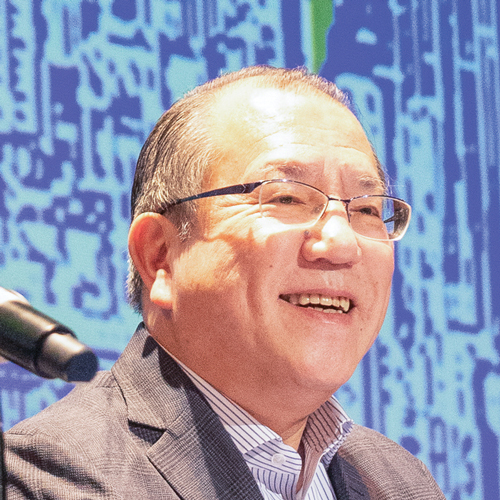
by Yoshiki Tanigawa
SGI Vice President
Congratulations today on this SGI-USA East Territory Leaders Meeting, bringing together leaders from Pennsylvania Zone, North Zone, New York Zone, Brooklyn-Queens-Long Island Zone and New Jersey Zone!
Let’s mark today’s meeting as a new launching point for further advancing kosen-rufu.
I’d like to reaffirm four basic and essential points that we should always strive to apply as leaders aiming to progress kosen-rufu.
1. Always Put Daimoku First.
The first key point is to always put chanting first.
On June 15, 1996, during Ikeda Sensei’s visit to New York, he shared the following guidance at a representatives meeting held at the New York Culture Center:
The first thing is to pray. From the moment we begin to pray, things start moving. The darker the night, the closer the dawn. From the moment we chant daimoku with a deep and powerful resolve, the sun begins to rise in our hearts.
Hope—prayer is the sun of hope. To chant daimoku each time we face a problem, overcoming it and elevating our life condition as a result—this is the path of “earthly desires are enlightenment” taught in Nichiren Daishonin’s Buddhism.
Suffering and undergoing hardships for the sake of friends and for spreading the Law are manifestations of the great sense of responsibility of a genuine leader and the behavior of a bodhisattva. There is no suffering or hardship that a Bodhisattva of the Earth cannot surmount. So no matter what happens, I would like you to advance steadily, one step at a time, always chanting Nam-myoho-renge-kyo with a vibrant voice.[1]
As Sensei says in this guidance, no matter what challenges we face, the most essential and fundamental first step is to chant daimoku. Then, as we chant, what’s vital is that we do so with the firm conviction that our prayers will definitely be answered.
In that same guidance from June 15, 1996, Sensei also cited this passage from “Reply to Kyo’o”:
Kyo’o’s misfortune will change into fortune. Muster your faith, and pray to this Gohonzon. Then what is there that cannot be achieved? (The Writings of Nichiren Daishonin, vol. 1, p. 412)
As a youth working for Josei Toda, whose businesses fell on hard times, Sensei also faced dire circumstances. While challenging his struggles then, he gave a lecture filled with a mighty fighting spirit on “Reply to the Lay Nun Nichigon.”
In this writing, Nichiren states:
Whether or not your prayer is answered will depend on your faith; [if it is not] I will in no way be to blame.
When water is clear, the moon is reflected. When the wind blows, the trees shake. Our minds are like the water. Faith that is weak is like muddy water, while faith that is brave is like clear water. Understand that the trees are like principles, and the wind that shakes them is like the recitation of the sutra. (WND-1, 1079)
Nichiren declares that whether our prayers are answered depends on our faith, and if they aren’t, it’s not Nichiren’s fault. His consistent message is that our own faith determines everything. And our faith is based on our unshakable conviction that the power of the Gohonzon and Nichiren Buddhism is absolute. What’s essential for us as leaders is to have rock-solid resolve that exudes this absolute conviction. And our powerful, conviction-filled prayer is the key to breaking through everything.
In The New Human Revolution, vol. 23, Sensei writes:
When we pray, it’s important to have a firm conviction that all our prayers will be answered and to pray with intensity. Mentors and disciples, Bodhisattvas of the Earth striving together for kosen-rufu, unite their hearts in prayer, so their prayers are certain to come true. When we truly pledge to achieve kosen-rufu as we chant, then our prayer is a prayer of the Bodhisattvas of the Earth. At that moment, our lives open and expand to that of the Bodhisattvas of the Earth.[2]
In addition, Sensei says:
Put your complete faith in the Gohonzon and pray with all your being. To realize your prayers and transform your karma, it’s vital to have firm conviction in faith. The power of the Gohonzon is absolute. The purpose of Buddhism is to enable all people to become happy.[3]
As leaders, our prayers filled with conviction and our vow for kosen-rufu serve as the tremendous driving force for achieving victories in our efforts for kosen-rufu and helping our fellow members become happy. Let’s engrave this point in our hearts.
2. Go Out to Meet People.
“Walking,” or going out to meet people—this is the second point for today. In taking on leadership, we start to learn about the diverse situations of the members of our local organizations. Some of us may become leaders in areas far from where we live and might not be familiar with many of the members at first.
Wherever we might be assigned, however, we must take on leadership with the resolve to take full responsibility for creating an organization in which each member can joyfully challenge their respective mission for kosen-rufu while winning in their efforts to revolutionize themselves and elevate their state of life.
The most practical thing we can do to move in this direction is to go out to meet and talk with each member individually. That’s how we come to know their worries and challenges, how we can chant with and encourage them. In other words, we must visit the members to get to know every inch of our organization.
As we visit each member, we get to know each person and the condition of their faith and daily life. When they start opening up to us about the issues they’re challenging, we can better understand how to chant for and encourage them. Repeating these efforts, again and again, is what gets the blood of our organization flowing.
If we think about how our body functions, our hands and feet move the way we want them to because the complex network of peripheral nerves delivers messages from our brain all the way down to our hands and feet.
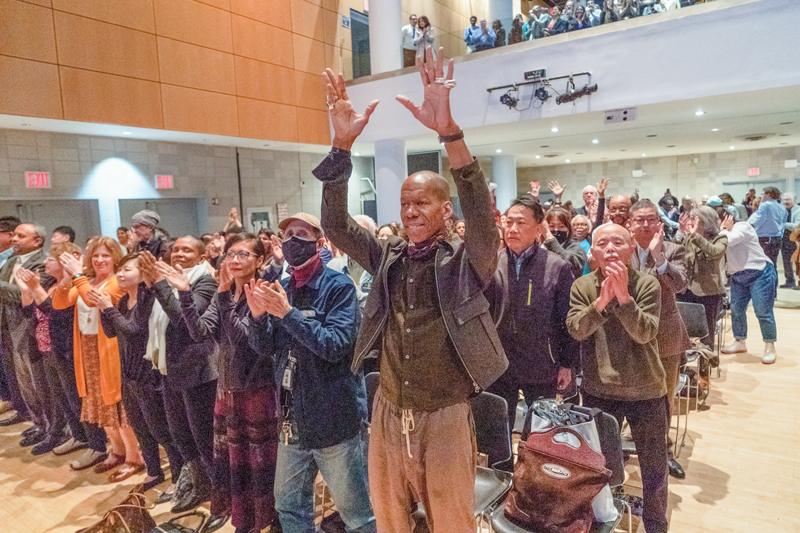
By using our membership list and taking steps to visit and meet each person on it one by one, we can deliver hand-crafted encouragement to them. This network of personal encouragement is what gets the engine going for expanding and advancing kosen-rufu in our local communities.
In volume 3 of The New Human Revolution, Sensei says the following:
If we use the allegory of the human body, the organization itself would correspond to the skeletal structure. So, though indispensable in its own way, the structure itself is not alive. President Toda’s greatness, I believe, lay in his continually infusing the organization with fresh life by tirelessly pumping the lifeblood of human warmth through its veins. Practically speaking, he did this by offering encouragement and guidance to each member.[4]
And in volume 7, he writes:
To willingly go anywhere to visit and encourage even one fellow member should be the spirit of the Soka Gakkai president and all Gakkai leaders. And this is all the more so when members are working hard under trying circumstances in areas where our membership is still small. …
The beauty and strength of the Soka Gakkai are to be found in the way seniors in faith treasure and care for younger or newer members, devoting themselves wholeheartedly to supporting, encouraging and nurturing them with utmost sincerity.
If I can communicate that to you, then my trip here will have been more than worthwhile—then there will be two more people who share that spirit with me.[/ref]NHR-7, revised edition, 213–14.[/ref]
Of course, it’s important to have meetings where members gather together and make efforts to ensure that such meetings and events are a success. However, the diligent and steady steps we take to encourage each member are even more crucial than that. That’s how we construct the grand path for expanding kosen-rufu. As leaders, I hope we can make this our primary focus and persevere in this greatest challenge.
3. Raise the Youth.
Raising the youth—this is the third point.
Ikeda Sensei shared the following guidance at the First SGI-USA Executive Conference on Feb. 21, 1990:
Something that characterizes true leaders is that they are thoroughly dedicated to raising young people. When you put all your energy into developing the rich potential of youth, both you and the organization are rejuvenated. I hope that you will find and raise people with great potential, allowing them to steadily grow and fully engage themselves. If you create such a flow, the future will open up boundlessly before you.[5]
As Sensei says, raising youth and nurturing our successors in the future division is crucial. I’m sure everyone here is well aware of this point. But the reality is that each generation differs in how they perceive things and their sensibilities. I often hear from older members that they don’t know how to communicate with young people and that it’s hard to interact with them confidently. Nowadays, younger generations have mastered communicating using social media and other advanced technology. With differences in experience and sensibilities, no matter the era or generation, this challenge has always existed.
What’s most important in resolving the differences between generations and in all matters related to exchanges of the heart, working together and in pooling our strengths to move things forward, is trying to get to know each person.
In the principle of uniting based on “many in body, one in mind,” many in body refers to individuality and people’s differing sensibilities and ways of thinking. While acknowledging our differences, we strive to be one in mind by having exchanges of the heart and coming together toward a shared vision.
As leaders, we must keep broadening our minds and hearts as we engage those around us. We shouldn’t “teach” the younger generation just because we are older. It’s good for us to try to “study” what the youth and future division members are interested in, how they perceive things around them and how they’re feeling.
We must persistently engage with them based on our belief in each person’s mission and potential. Even if we don’t hit it off right away, through making prayer our foundation and taking action to connect with each young person, we come to know them better. We can begin to see the incredible potential they themselves often cannot see, and we can help nurture that potential. Sensei says that offering guidance means lightening the burden in people’s hearts.
We tend to follow the guideline that the greatest measure of a person’s encouragement is when the young people they support stand up to take the lead. But people have different personalities and outlooks. So it’s vital that we warmly embrace and help each person just as they are.
Sensei has said that once people awaken to their mission, their unique talents quickly develop.
Nichiren Daishonin writes:
No one was found there who could embrace these sutras and teach them to others. It was as though there were only wooden or stone statues garbed in priests’ robes. (“On the Buddha’s Prophecy,” WND-1, 401)
Just as he says, if we don’t foster successors, the flow of kosen-rufu will stop. As leaders, let’s keep this most crucial point in mind as we give our all to raising successors.
As for the youth who are here today, I would like to ask that you advance by engraving in your hearts Sensei’s following guidance from My Dear Friends in America:
It’s not up to others—everything depends on ourselves. As leaders of kosen-rufu, we should first pray ourselves. Being a leader is not a matter of getting others to do things; it is to become an engine and set oneself in motion. This is the key to victory in all endeavors.
It is important that youth, in particular, actively seek challenges to forge and strengthen themselves. Those who enjoy material luxury from a young age and do not work hard cannot become people of outstanding character. They cannot become great leaders who protect the people.
I hope you will work hard, sparing no effort, and develop yourselves as indomitable champions whom nothing can shake or dishearten.[6]
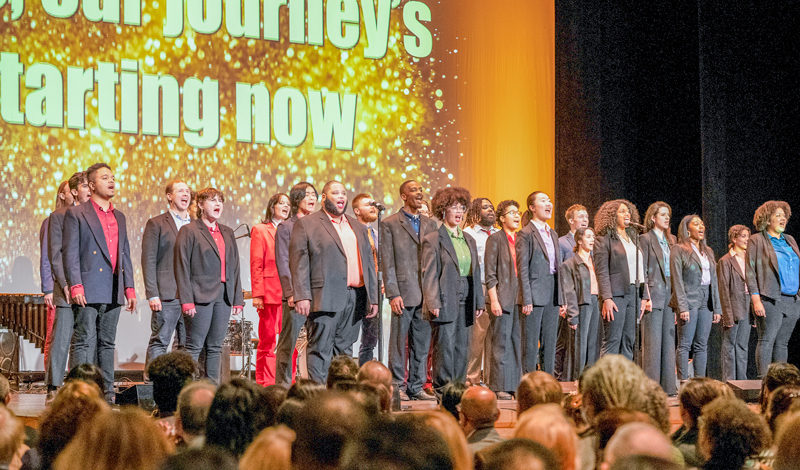
4. Reaffirm the Buddhist Spirit of Offerings.
For my fourth point, I’d like to talk about the May Commemorative Contribution activity in which you are all engaged right now. I’d like to confirm some points about the spirit of making offerings in Buddhism.
In “Letter from Sado,” Nichiren states:
Since nothing is more precious than life itself, one who dedicates one’s life to Buddhist practice is certain to attain Buddhahood. If one is prepared to offer one’s life, why should one begrudge any other treasure for the sake of Buddhism? On the other hand, if one is loath to part with one’s wealth, how can one possibly offer one’s life, which is far more valuable? (“Letter from Sado,” WND-1, 301)
And in “The Fourteen Slanders,” he also says:
Even though you may be too poor to offer anything of value, if the opportunity should arise to give up your life to acquire the Law of the Buddha, you should offer your life in order to pursue the Law.
This body of ours in the end will become nothing more than the soil of the hills and fields. Therefore, it is useless to begrudge your life, for though you may wish to, you cannot cling to it forever. (“The Fourteen Slanders,” WND-1, 760)
The questions are: What are you reluctant or “loath to part with”? Or, what attachments do you have? These things express our state of life. What’s more, we all hesitate to offer up our life.
In his lecture on “Letter from Sado,” Sensei says:
One lesson … is that simply clinging to our lives will not result in attaining genuine happiness. Establishing a fundamental purpose and pursuing the correct course in life—ready to face any hardship this might entail—enables us to experience deep joy and fulfillment. If we allow ourselves to be controlled by shallow desires and hold fast to our lesser selves at a crucial moment, then our hearts will wither, and only misery and regret will await us.
Another lesson is that the lofty state of life gained through Buddhist practice is eternal, transcending the limited nature of our present existence. By dedicating this precious lifetime to Buddhism, we are certain to enjoy abundant happiness and benefit in all future lifetimes.[7]

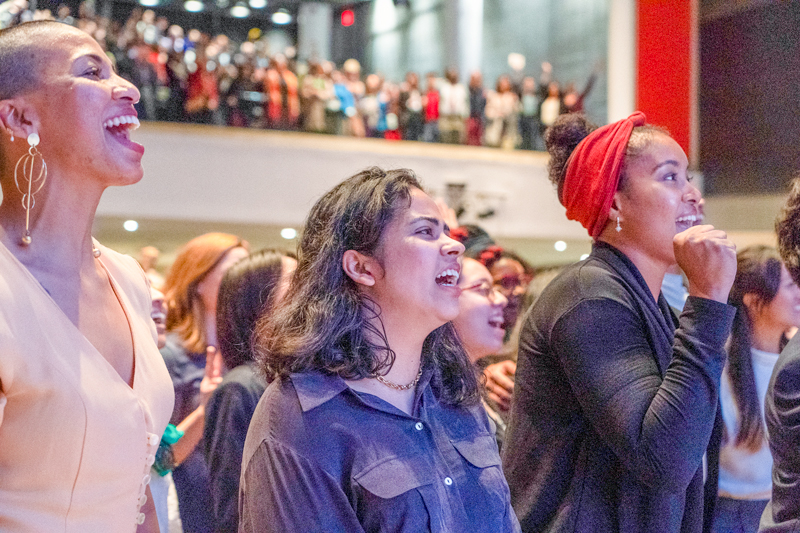
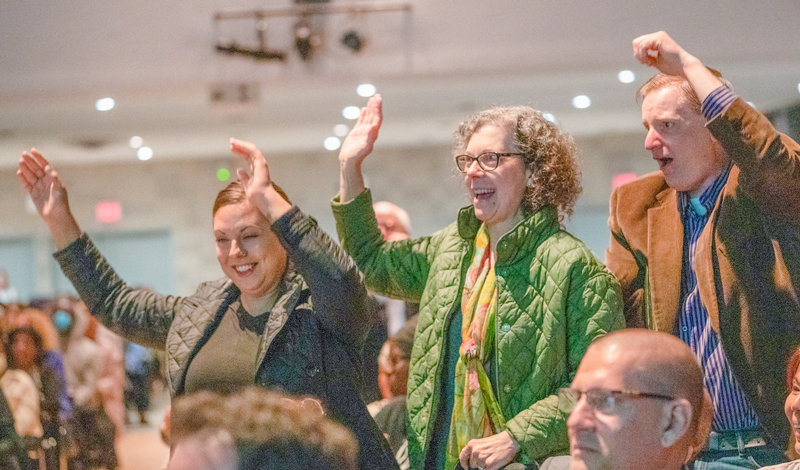
There is also a well-known passage from “The Gift of Rice,” which states:
As for the matter of becoming a Buddha, ordinary people keep in mind the words “earnest resolve” and thereby become Buddhas. (WND-1, 1125)
The Daishonin continues:
What is appropriate for sages is offering in actuality [offering one’s life itself for the Law]. What is appropriate for ordinary people is offering in principle [sincerely offering what is important to one’s own life]. This is the teaching called the paramita of almsgiving for the observation of the mind that is set forth in the seventh volume of Great Concentration and Insight. (“The Gift of Rice,” WND-1, 1126)
The “paramita of almsgiving” refers to the practice of making offerings. When we become attached to what we have gained from our Buddhist practice or to our material possessions and hesitate to share them with others, that becomes an obstacle for revealing our inherent life state of Buddhahood.
The hesitation to part with our possessions restricts us, and that is why we need to break our attachments to put our lives on course to revealing our Buddhahood. And we can do this by joyfully making offerings or contributions and joyfully engaging in sharing Buddhism with others. Challenging ourselves to take action with joy is the direct path to happiness.
We need to have courage to confront our attachments. We all hesitate to part with our money or possessions. However, greed, which has no limit, can cause damage to our own life or to the relationships we have with others.
On the other hand, sincerely contributing to ensure that our kosen-rufu movement progresses for the happiness of all people is proof that we are readily breaking our attachments. We also must fight to break through our tendency to fear how others might respond to us. We break through that fear by making efforts to meet people in person and widely share our amazing Buddhist practice. In other words, to open wide our life condition we need to challenge ourselves to broadly spread Nichiren Buddhism.
For this reason, I hope that you can make prayer your foundation and joyfully promote this month’s contribution activity so that your fellow members can construct absolutely happy lives.
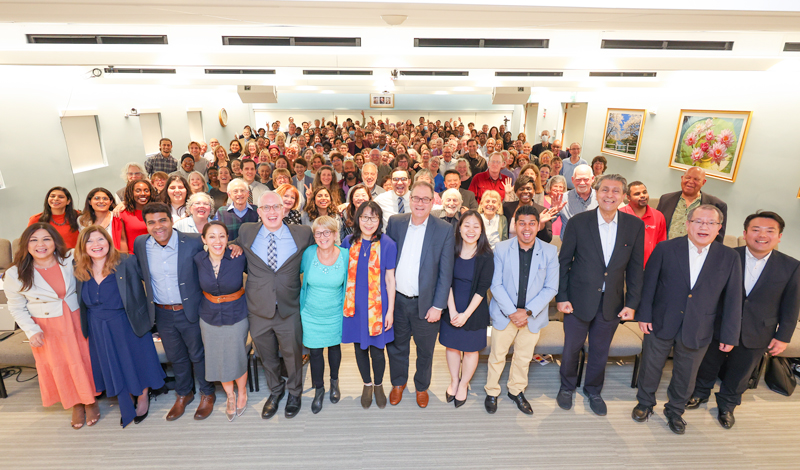
Create an Excellent Foundation for Rapid Growth.
I have just shared four practical action points to apply as leaders of our movement.
Regarding the mission of members in New York, Sensei has said:
With its rich diversity, New York is the world in miniature. In such a setting, you New York SGI members are taking on a challenging and crucially important issue for humankind—respecting and creating harmony amid diversity. Without doubt, Nichiren Daishonin is watching over and protecting this solidarity of the Buddha’s children in New York.[8]
To you, the leaders of East Territory: You are all people with the vital mission to realize and advance based on Sensei’s vision.
Especially at this time, when divisiveness and conflict seem to be intensifying in various arenas throughout the world, the urgency to realize Sensei’s vision is greater than ever.
As the saying goes, “Dig where your feet are planted, and there you will find a spring.” Even when trying to realize a long-range goal—or precisely because we set a grand, long-range goal—the only way to advance toward that goal is to start where we are and take concrete actions one step at a time.
We, of course, should chant powerfully to succeed in every effort we make, but realistically speaking, there is no formula or set way to dramatically transform everything all at once.
The well-known theme of human revolution is:
A great human revolution in just a single individual will help achieve a change in the destiny of a nation, and further, can even enable a change in the destiny of all humankind.[9]
Nichiren Daishonin, too, says:
At first only Nichiren chanted Nam-myoho-renge-kyo, but then two, three, and a hundred followed, chanting and teaching others. Propagation will unfold this way in the future as well. Does this not signify “emerging from the earth”? (“The True Aspect of All Phenomena,” WND-1, 385)
All change begins with one person.
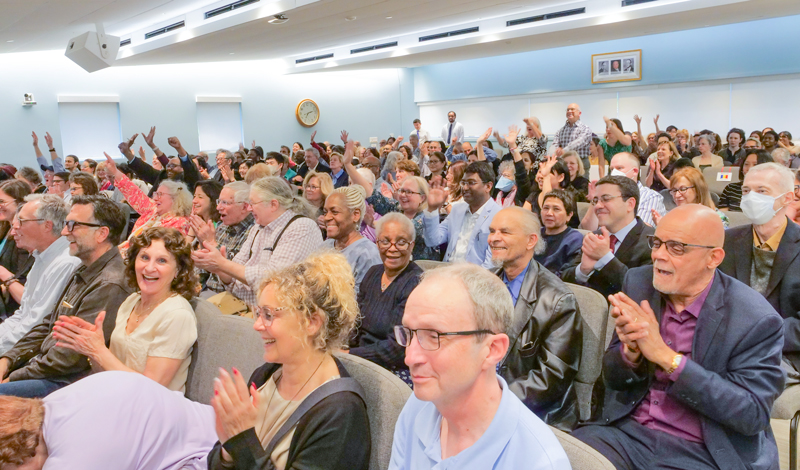
Digging where our feet are planted means cultivating good relationships with those around us. Our parents, partners, children, siblings, relatives, co-workers or local fellow members—each of us has unique connections with the people in our various circles. And each person we know is challenging one kind of issue or another.
And the reality that each person faces is their “land” or place of mission for kosen-rufu; it’s the stage for carrying out their human revolution and transforming their state of life. Working for the happiness of self and others is not an abstract idea. We carry out our practice for ourselves and others within our relationships with those around us. This practice is our battle to truly become individuals who can sincerely pray for each person’s happiness.
Do we become lost in our attachments to differences and incapable of overcoming conflict and division? Or do we become people who can look beyond differences and discover more profound commonalities that awaken us to the dignity of our lives and who can turn our differences into the fuel for creating new values and ways of thinking.
We cannot simply be satisfied to understand these things as theories or principles. We must strive to apply these ideals to our lives and experience them. Our practice of Nichiren Buddhism enables us to bring these ideals to life.
By making our faith our foundation, we can summon the courage to face each issue and karmic challenge head-on, pray profoundly and persevere in our efforts. Repeating this process can generate a great flow of change and victory.
This is the grand path of challenge we engage in as we carry out kosen-rufu. Giving our all in our SGI activities is the key to establishing a strong core of harmony and connection among people that can conquer divisiveness; our activities are crucial to transforming the destiny of all humanity.
Whether sharing Buddhism to expand our movement, raising capable people or engaging in your current May Contribution activity efforts—we are creating an excellent foundation for rapid growth by fully engaging in every activity and accomplishing each goal in front of us.
Please take pride in the palace of capable people you are constructing, where all will stand up as disciples united with their mentor to advance global kosen-rufu and transform humankind’s destiny.
To all of the East Territory leaders gathered here today: I will be sending daimoku for you to be at the vanguard of kosen-rufu in America, the center of global kosen-rufu, and for you to advance powerfully with joy, cheer and the unity of many in body, one in mind!
June 2, 2023, World Tribune, pp. 6–10
References
- My Dear Friends in America, third edition, pp. 463–64. ↩︎
- The New Human Revolution, vol. 23, p. 315. ↩︎
- NHR-25, 247. ↩︎
- NHR-3, revised edition, 234. ↩︎
- My Dear Friends in America, third edition, p. 58. ↩︎
- Ibid., 487. ↩︎
- The Teachings for Victory, vol. 1, p. 7. ↩︎
- My Dear Friends in America, third edition, p. 462. ↩︎
- The Human Revolution, p. viii. ↩︎
You are reading {{ meterCount }} of {{ meterMax }} free premium articles

